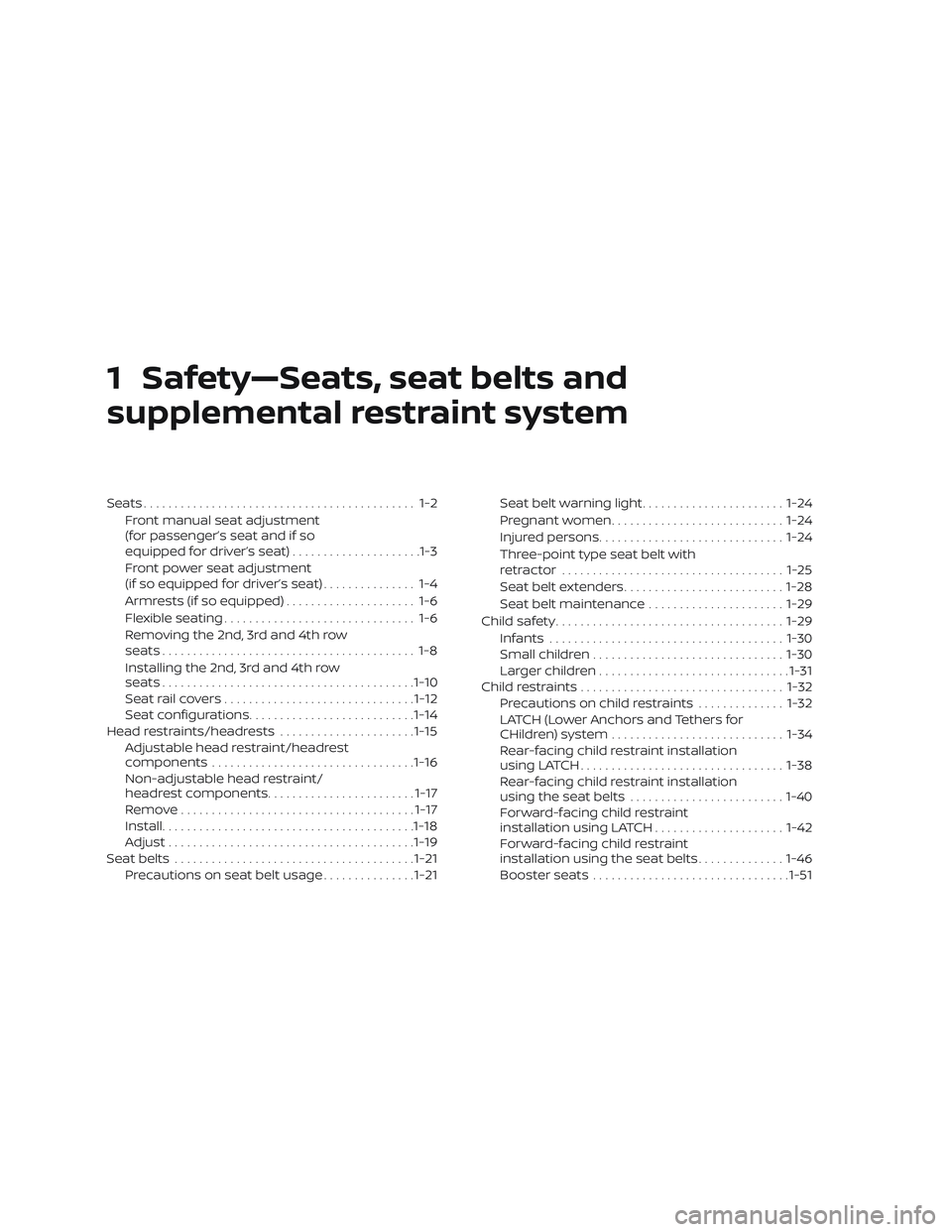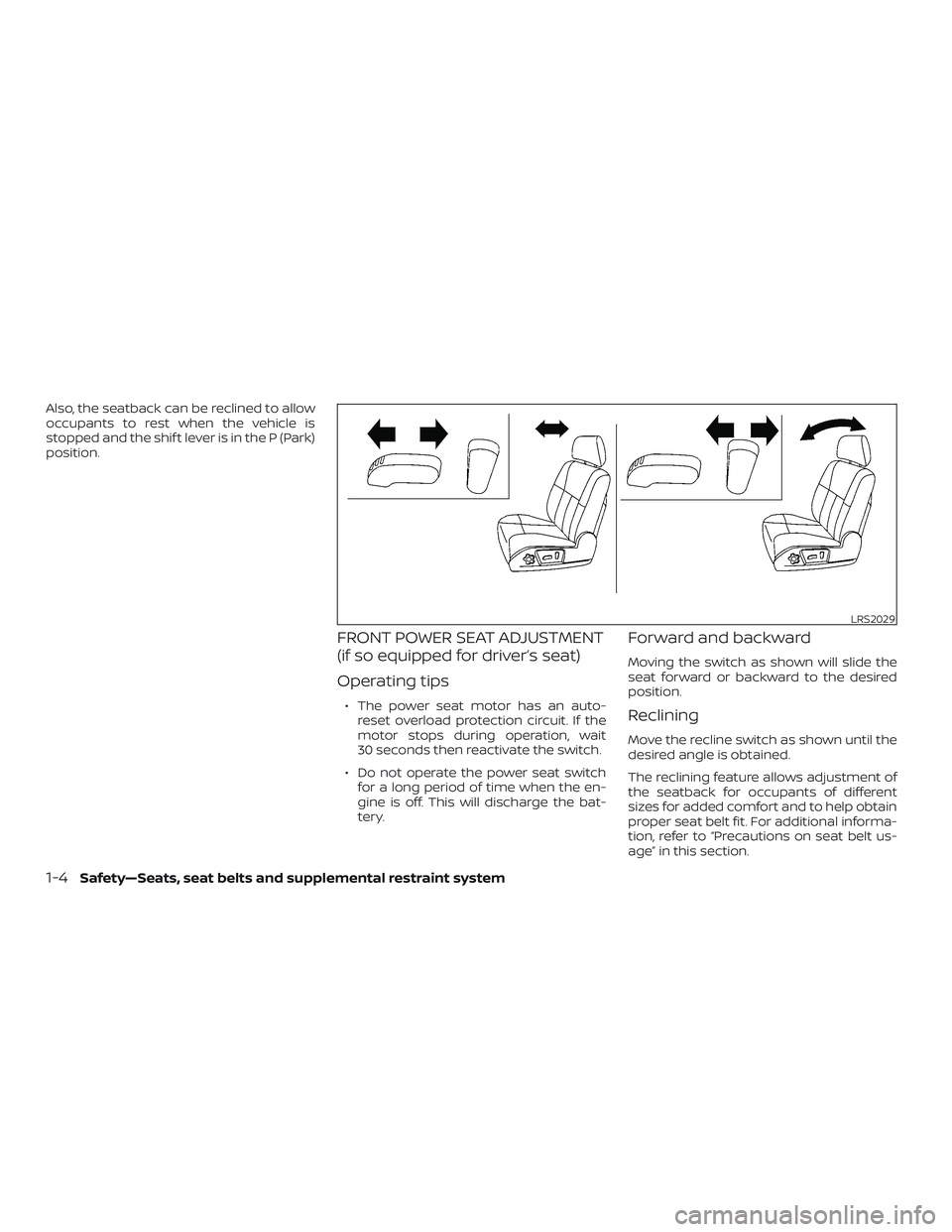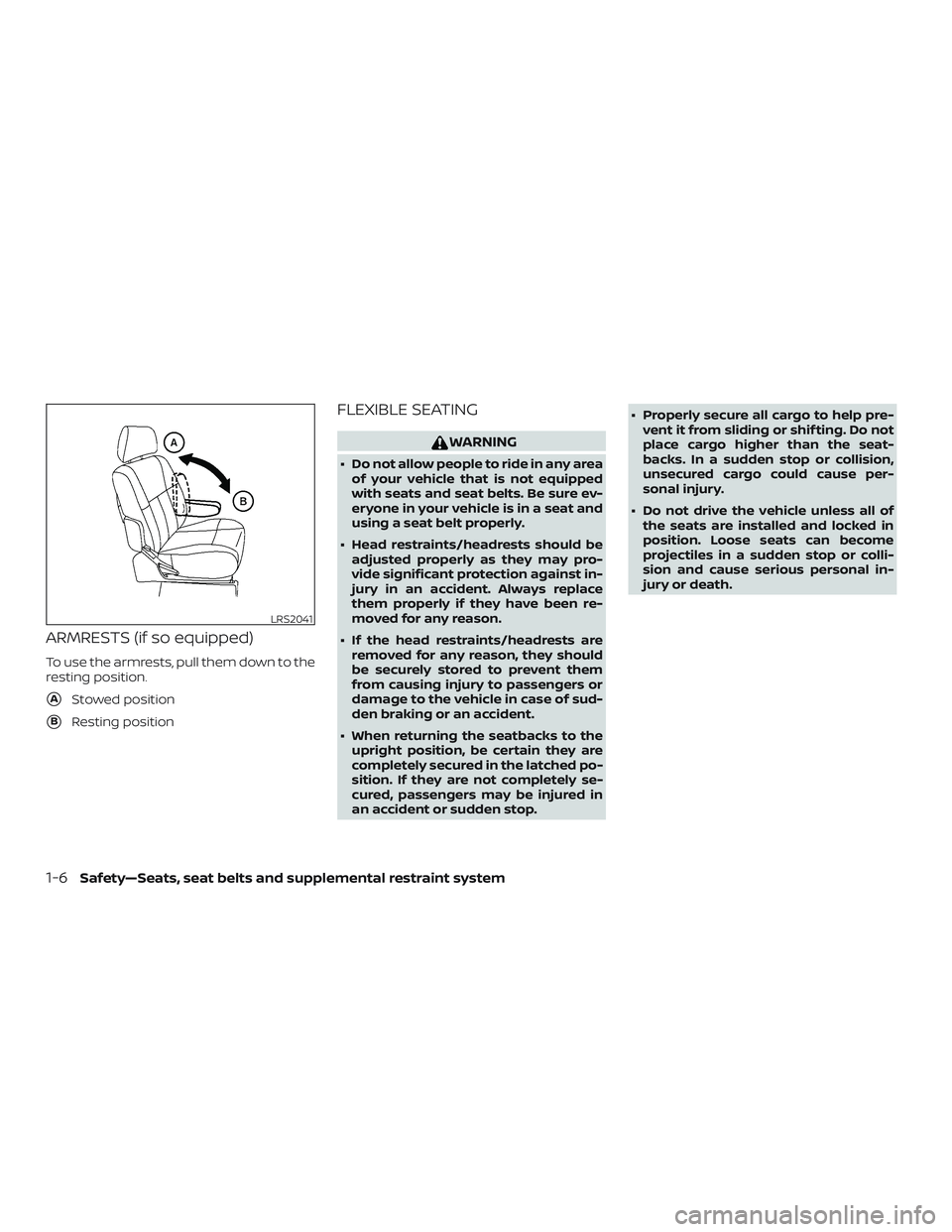Page 8 of 426
Table of
ContentsIllustrated table of contents
Safety—Seats, seat belts and supplemental restraint system
Instruments and controls
Pre-driving checks and adjustments
Monitor, climate, audio, phone and voice recognition systems
Starting and driving
In case of emergency
Appearance and care
Do-it-yourself
Maintenance and schedules
Technical and consumer information
Index
0
1
2
3
4
5
6
7
8
9
10
11
Page 11 of 426
1. Head restraints/headrests(2nd, 3rd and 4th rows) (P. 1-15)
2. LATCH (Lower Anchors and Tethers
for CHildren) system (second row
shown; 3rd and 4th rows similar)
(P. 1-32)
3. Head restraints/headrests
(front row) (P. 1-15)
4. Front seat belts (P. 1-21, 1-55)
5. Roof-mounted curtain side-impact
and rollover supplemental air bag
(P. 1-55)
6. Supplemental air bags (P. 1-55)
7. Front seats (P. 1-2)
8. Front seat-mounted side-impact
supplemental air bag (P. 1-55)
9. Top tether strap anchor points
(2nd, 3rd, and 4th rows — found on
bottom of seatback) (2nd row
shown; other rows similar) (P. 1-32)
10. Rear seat configurations (P. 1-2)
Refer to the page number indicated in
parentheses for operating details.
LII2319
AIR BAGS, SEAT BELTS AND CHILD
RESTRAINTS
0-2Illustrated table of contents
Page 21 of 426

1 Safety—Seats, seat belts and
supplemental restraint system
Seats............................................ 1-2Front manual seat adjustment
(for passenger’s seat and if so
equipped for driver’s seat) .....................1-3
Front power seat adjustment
(if so equipped for driver’s seat) ............... 1-4
Armrests (if so equipped) ..................... 1-6
Flexible seating ............................... 1-6
Removing the 2nd, 3rd and 4th row
seats......................................... 1-8
Installing the 2nd, 3rd and 4th row
seats......................................... 1-10
Seatrailcovers............................... 1-12
Seat configurations ........................... 1-14
Head restraints/headrests ......................1-15
Adjustable head restraint/headrest
components ................................. 1-16
Non-adjustable head restraint/
headrest components ........................ 1-17
Remove...................................... 1-17
Install ......................................... 1-18
Adjust ........................................ 1-19
Seatbelts ....................................... 1-21
Precautions on seat belt usage ...............1-21Seat belt warning light
....................... 1-24
Pregnant women ............................ 1-24
Injured persons .............................. 1-24
Three-point type seat belt with
retractor .................................... 1-25
Seat belt extenders .......................... 1-28
Seat belt maintenance ......................1-29
Child safety ..................................... 1-29
Infants ...................................... 1-30
Small children ............................... 1-30
Larger children ............................... 1-31
Child restraints ................................. 1-32
Precautions on child restraints ..............1-32
LATCH (Lower Anchors and Tethers for
CHildren) system ............................ 1-34
Rear-facing child restraint installation
using LATCH ................................. 1-38
Rear-facing child restraint installation
using the seat belts ......................... 1-40
Forward-facing child restraint
installation using LATCH .....................1-42
Forward-facing child restraint
installation using the seat belts ..............1-46
Booster seats ................................ 1-51
Page 23 of 426

WARNING
∙ Do not ride in a moving vehicle whenthe seatback is reclined. This can be
dangerous. The shoulder belt will not
be against your body. In an accident,
you could be thrown into it and re-
ceive neck or other serious injuries.
You could also slide under the lap belt
and receive serious internal injuries.
∙ For the most effective protection when the vehicle is in motion, the seat
should be upright. Always sit well
back and upright in the seat with both
feet on the floor and adjust the seat properly. For additional information,
refer to “Precautions on seat belt us-
age” in this section.
∙ Af ter adjustment, gently rock in the seat to make sure it is securely locked.
∙ Do not leave children unattended in- side the vehicle. They could unknow-
ingly activate switches or controls or
make the vehicle move. Unattended
children could become involved in se-
rious accidents. ∙ To help avoid risk of injury or death
through unintended operation of the
vehicle and/or its systems, do not
leave children, people who require the
assistance of others or pets unat-
tended in your vehicle. Additionally,
the temperature inside a closed ve-
hicle on a warm day can quickly be-
come high enough to cause a signifi-
cant risk of injury or death to people
and pets.
∙ Do not adjust the driver’s seat while driving so full attention may be given
to vehicle operation. The seat may
move suddenly and could cause loss
of control of the vehicle.
∙ The seatback should not be reclined any more than needed for comfort.
Seat belts are most effective when the
passenger sits well back and straight
up in the seat. If the seatback is re-
clined, the risk of sliding under the lap
belt and being injured is increased.
CAUTION
When adjusting the seat positions, be
sure not to contact any moving parts to
avoid possible injuries and/or damage.
ARS1152
SEATS
1-2Safety—Seats, seat belts and supplemental restraint system
Page 24 of 426
FRONT MANUAL SEAT
ADJUSTMENT (for passenger’s
seat and if so equipped for
driver’s seat)
Your vehicle seats can be adjusted manu-
ally. For additional information about ad-
justing the seats, refer to the steps outlined
in this section.
Forward and backward
Pull the lever up and hold it while you slide
the seat forward or backward to the de-
sired position. Release the lever to lock the
seat in position.
Reclining
To recline the seatback, pull the lever up
and lean back. To bring the seatback for-
ward, pull the lever up and lean your body
forward. Release the lever to lock the seat-
back in position.
The reclining feature allows adjustment of
the seatback for occupants of different
sizes for added comfort and to help obtain
proper seat belt fit. For additional informa-
tion, refer to “Precautions on seat belt us-
age” in this section.
LRS2038LRS2039
Safety—Seats, seat belts and supplemental restraint system1-3
Page 25 of 426

Also, the seatback can be reclined to allow
occupants to rest when the vehicle is
stopped and the shif t lever is in the P (Park)
position.
FRONT POWER SEAT ADJUSTMENT
(if so equipped for driver’s seat)
Operating tips
∙ The power seat motor has an auto-reset overload protection circuit. If the
motor stops during operation, wait
30 seconds then reactivate the switch.
∙ Do not operate the power seat switch for a long period of time when the en-
gine is off. This will discharge the bat-
tery.
Forward and backward
Moving the switch as shown will slide the
seat forward or backward to the desired
position.
Reclining
Move the recline switch as shown until the
desired angle is obtained.
The reclining feature allows adjustment of
the seatback for occupants of different
sizes for added comfort and to help obtain
proper seat belt fit. For additional informa-
tion, refer to “Precautions on seat belt us-
age” in this section.
LRS2029
1-4Safety—Seats, seat belts and supplemental restraint system
Page 26 of 426
Also, the seatback can be reclined to allow
occupants to rest when the vehicle is
stopped and the shif t lever is in P (Park).
Seat lif ter
Move the switch as shown to adjust the
angle and height of the seat cushion.
Lumbar support
The lumbar support feature provides ad-
justable lower back support to the driver.
Turn the knob forward or backward to ad-
just the seat lumbar area.
LRS2030LRS2040
Safety—Seats, seat belts and supplemental restraint system1-5
Page 27 of 426

ARMRESTS (if so equipped)
To use the armrests, pull them down to the
resting position.
�AStowed position
�BResting position
FLEXIBLE SEATING
WARNING
∙ Do not allow people to ride in any areaof your vehicle that is not equipped
with seats and seat belts. Be sure ev-
eryone in your vehicle is in a seat and
using a seat belt properly.
∙ Head restraints/headrests should be adjusted properly as they may pro-
vide significant protection against in-
jury in an accident. Always replace
them properly if they have been re-
moved for any reason.
∙ If the head restraints/headrests are removed for any reason, they should
be securely stored to prevent them
from causing injury to passengers or
damage to the vehicle in case of sud-
den braking or an accident.
∙ When returning the seatbacks to the upright position, be certain they are
completely secured in the latched po-
sition. If they are not completely se-
cured, passengers may be injured in
an accident or sudden stop. ∙ Properly secure all cargo to help pre-
vent it from sliding or shif ting. Do not
place cargo higher than the seat-
backs. In a sudden stop or collision,
unsecured cargo could cause per-
sonal injury.
∙ Do not drive the vehicle unless all of the seats are installed and locked in
position. Loose seats can become
projectiles in a sudden stop or colli-
sion and cause serious personal in-
jury or death.
LRS2041
1-6Safety—Seats, seat belts and supplemental restraint system